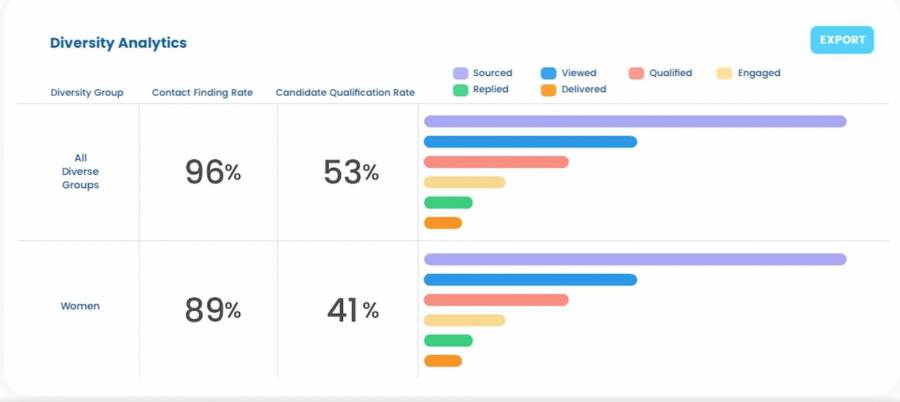Politics
A Guide – The Role of AI in Recruitment (+ Top 5 AI Recruiting Tools)
Published
3 years agoon
By
Drew Simpson
Artificial intelligence is gaining more and more attention. Intelligent self-learning programs disrupt many industries, including eCommerce, manufacturing and production lines, transportation, agriculture, logistics and supply chain, and more. Moreover, such programs automate redundant processes and don’t require a high level of creativity, increasing its overall effectiveness.
“It is difficult to think of an industry that AI will not transform. This includes healthcare, education, transportation, retail, communications, and agriculture. There are surprisingly clear paths for AI to make a big difference in all of these industries.” – Andrew Ng, Founder, and CEO of Landing AI
Innovative Application of AI in Recruitment
These disruptive forces have started hitting the HR industry as well. And it’s not just a trend; the innovations brought by AI are going to stay. Moreover, it’s anything but a temporary phenomenon. The most recent development in HR technology is AI in recruitment. The changes brought by AI in recruitment will be significant since many recruitment aspects have redundant, time-consuming tasks that can be easily automated.
Apart from that, AI can bring innovative solutions to the new-age emerging problems faced in HR and recruitment, like managing a multi-generational workforce, rising mental health issues, promotion, or inclusive culture.
The entire HR industry will be going under major changes while AI makes their jobs easier, faster, and better.
This article will explore the role of AI in recruitment, its possible use cases, top tools available in the market to automate recruitment processes, potential challenges attached with the adoption of AI, and its overall impact.
The Role of AI in Recruitment — nine helps for recruitment
According to 52% of talent acquisition leaders, the most challenging part of recruitment is screening and short-listing candidates from a large talent pool. When integrated with applicant tracking software (ATS), an AI screening software can make hiring recommendations by utilizing data like candidates’ performance, merits, experience, etc.
The AI screening software can learn from existing candidates’ experience and skillsets and make recommendations accordingly.
Screening resumes still make up for the largest part of a recruiters’ daily schedule. Implementation of AI for resume screening can free up recruiters’ time to a great extent enabling them to screen effectively from the shortlisted candidates.
AI chatbots for recruitment work as recruiter’s assistant where chatbots can collect candidates’ basic information like education, experience and ask basic screening questions. Based on the inputs, the chatbot can rank the recruiter candidates saving their time and efforts.
Chatbots can also resolve candidates’ doubts that fall into frequently asked questions and set up interviews with worthy candidates, thereby automating almost 80% of top-of-the-funnel/pre-screening activities.
-
Automated Candidate Sourcing
Sourcing candidates to build the recruitment pipeline is a time-consuming and challenging task. AI for candidate sourcing can extend recruiters’ reach as artificial intelligence can scan millions of profiles in a matter of seconds from multiple job portals, social media platforms, and more.
Normally, a recruiter takes about 6 secs to scan a single resume, and a single corporate job opening attracts around 250 resumes. That’s almost 3-4 working days’ worth of just scanning resumes for a single position. AI can automate this part of the process, and recruiters can focus on the hiring process’s next levels.
Since AI can go through heaps and heaps of data in seconds, it will optimally use your company’s database of past candidates. So, rather than spending a great deal of money on sourcing new candidates, you can utilize the existing candidate pool to find a strong candidate who might be fit for existing job openings.
Around 3.2% of the entire workforce of the USA works remotely. And almost 16% of companies hire remote worlds exclusively.
The numbers will grow from here on out since the pandemic redefined the working culture for many companies.
This means it will get harder for recruiters to hire people since hiring remote workers comes with its own set of challenges. However, using AI-powered pre-assessment tools, video interviews combined with a hint of AI, and more can enable recruiters to hire better and faster.
Recruiters can expand their efforts for diversity hiring by implementing AI-powered solutions. For example, a startup called Gapjumpersdotme uses AI to analyze your current screening, hiring, and promotion processes, blind hiring, and creating inclusive job ads.
Around 56% of candidates believe AI may be less biased than recruiters, and about 49% think that implementing AI might increase their chances of getting hired.
Recruiters might be aware of their conscious biases, but it might be possible to be unaware of subconscious biases. And it’s becoming more and more important to promote diversity in the workplace since it improves employee productivity, happiness, retention, creativity, and more.
-
Facial Expression Analysis
Video interviews can save an ample amount of time for both the parties, candidates and employers. And video interviews with AI in the mix can analyze a candidate’s expressions, capture and analyze their moods, assess their personality traits, and more.
Big companies like Unilever, Dunkin’ Donuts, IBM, etc., already use AI in their video interviews and claim that it has increased ethnic and socioeconomic diversity in their hiring.
-
Customized Employee Value Propositions
Your employee value propositions can’t follow the doctrine of “one fit for all.” Every employee has a different set of skills, experience, and more importantly, their needs, goals, and aspirations are unique to them.
What’s valuable to one employee can be useless to the other. For example, an employee living within 2 miles from the office building won’t use company vehicles or car services. On the other hand, an employee who lives in the suburbs with a good 25 miles between their house and the office will be grateful to have a company vehicle or car service.
Providing custom-tailored value propositions to your employees can result in improved productivity and a happier workforce.
AI can analyze your employees’ behavior, personality traits, and more to personalize your company’s value proposition to an employee.
Such personalization can help you craft lucrative offers for the high-demand candidates, directly improving your overall conversion rates.
-
Quicker background checks
Background check is an essential part of the hiring process. This is the stage where the recruiter verifies the candidate’s credentials, experience, education, etc. Conventionally, this process is quite tedious and time-consuming.
But with AI-powered tools, this process can be made efficient, private, unbiased, and faster.
Checkr is one such platform that automates the process of background checks with its AI-powered solutions. Their solutions are used by companies like Netflix, Airbnb, Instacart, etc.
Here are 7 top AI-enabled tools you may find useful
Companies like Nike, General Dynamics, Intel, and Wayfair, Hiretual helps your talent sourcing teams source and engage the right applicants for opening job positions. Their tools provide a set of features like AI sourcing, market insights for creating effective hiring strategies, personalized outreach with candidates, diversity & inclusive hiring, and 30+ ATS integrations that fetch the right data in real-time.

Used by companies like McDonald’s, MARS, MOL Group, and ExxonMobil, XOR helps attract, engage, and recruit candidates efficiently. They offer features like live chat, virtual career fairs, WhatsApp campaigns, on-demand video interviews, recruiter and HR connect, and more.
XOR modernizes your recruitment processes and allows your HR and recruitment teams to leverage the power of AI, the internet, and social media platforms from one platform.

Used by companies like AirAsia, TATA Communications, HULU, and Twilio, Eightfold uses AI to guide your career site visitors to the right job openings. Further, they provide talent acquisition, talent diversity, talent management, and talent experience solutions to streamline every recruitment process aspect.
The conversion rates drastically increase with Eightfold.ai in the picture because of their predictions.

Humanly is a recruitment tool that majorly focuses on diversity hiring and seamlessly integrates with top ATS vendors. With their AI-powered chatbots, your recruitment team can automate candidates’ screening and interview scheduling in a DEI (diversity ethnicity inclusivity) friendly manner.
Used by Armoire, Tiny Pulse, Swiss Monkey, Oakland Roots, and BPM, Humanly claims to have saved over 60 hours scheduling and screening per job opening and 95% completion of background checks within 48 hours.

Used by companies like Chick-a-fila, Six Flags, Ocada Group, Agoda, and B&M, MyInterview leverages the power of AI and machine learning to analyze candidates’ answers for professionalism, reasoning, and more.
Their tools provide candidate insights using deep analytics and empower recruiters to customize their candidates’ experiences. For example, you can review interviews, shortlist candidates, collaborate with stakeholders more efficiently.

Used by Amazon, Onpartners, CT Assist, Three Pillars, and more, Loxo is a hiring and recruitment automation platform. It is a complete HR CRM that comes equipped with recruitment CRM, a talent intelligence system, and an application tracking system.
Known for their modern features like smart grids and task management, Loxo claims to have an updated database of over 530 million people and over 98% customer satisfaction rate.

Used by the likes of Twitter, Salesforce, Waymo, and Rover, Seekout is an AI-powered talent search engine that lets you search for talent in a way that’s comfortable for you. You can use their search engine for direct search, boolean search, and apply power filters or leverage AI matching benefits.
Seekout’s AI can shortlist candidates based on the job description added. This list is curated either from its own 500 million talent profiles or from your ATS. Additionally, you can reach out to the candidates with personalized messages and automated outreach sequences.
Other prominent features that they provide are talent analysis, candidate engagement, diversity hiring, and more.
You can also download their chrome extension that provides an added level of ease to your recruitment process.
Impact of AI on Recruitment
Roughly 75% to 88% of candidates applying for a particular position are underqualified or not a right fit. And for every job opening, it takes recruiters a good 23 hours to scan through all the applications and resumes.
More importantly, the volume of applications will increase in the near future, considering the recent developments in the unemployment rates because of the pandemic. At the same time, the recruitment and HR teams are predicted to remain the same size.
This only means that they’ll have to put in more effort with fewer than the necessary number of the hands-on deck.
Since AI can automate candidates’ screening and scheduling, it saves quite a lot of time and recruiters’ resources. And since you’ll be faster and efficient with your processes, the chances of losing a good candidate to your competitors become quite low.
-
The quality of hiring improves
The talent pool gets bigger and bigger every year unless the job listings are for unconventional roles. Then, the recruiters have to screen the entire talent pool to get to the right batch of candidates, which is tiring and time-consuming.
With AI in screening, recruiters will get a list of shortlisted candidates perfect for the jobs. Then, they will have to screen them further on the impersonal attributes like cultural fit, previous organizational behavior, etc. Needless to say, this drastically improves the quality of the hired candidates.
-
Better integration of analytics
AI-backed tools and software come equipped with high-level analytics, providing recruiters with insights about every aspect of their process. Using these insights, they can easily optimize their operations and make the most of their time and resources.
-
Improves candidate experience
AI tools like chatbots used for the pre-screening stage are online 24/7. This means whenever any candidates reach out to apply, ask questions, etc., the chatbots are there to clear their doubts and provide the necessary information regarding the job role and responsibilities, company overview, and more.
AI can provide candidates with detailed support throughout the application process, guiding them whenever they get stuck or solving their queries.
This improves their overall experience with the recruitment process and creates a positive image for your brand. This can translate into getting more referrals from the candidates, making it easier for recruiters to expand their reach without investing time or money.
Challenges of Adopting AI in Recruitment
Chatbot conversations can lack the human touch, can be perceived as robotic, and it is quite possible that the bots might not be able to parse human lingo, cultural context, everyday slang, etc.
Moreover, around 80% of candidates would prefer to have human interactions over AI-powered chats with bots.
The candidate’s experience might get impacted negatively by the use of AI.
-
Requires the input of a lot of data
To mimic human intelligence, AI-powered programs require the input of a great deal of data. If not, then you can’t expect accuracy in results generated from implementing AI-powered programs and tools.
Good recruiters judge candidates’ resumes based on their years of experience in dealing with candidates. Unfortunately, AI can’t mimic seasoned recruiters’ accuracy and judgment unless fed with heaps and heaps of data.
AI-powered tools are created based on previous data. The data originated from years of recruiters’ screening of candidates. The chances of recruiters having tapped into their unconscious bias in their screening and hiring candidates are quite high.
So, the possibility of AI learning human biases is not lost on us.
The only way to ensure that your AI tools are not replicating human biases is to have a vendor that’s well-aware of such issues and has taken steps to remove patterns of such biases.
-
Can be taken with a grain of salt/skepticism
Changing old ways, adopting new technologies and practices can be hard, in general. As a result, it is quite possible that HR and recruitment professionals might take these tools and software with a grain of salt.
Learning to work with a new tool and process is as hard as unlearning old ways and processes.
AI can be unreliable in candidate screening, especially when it encounters unconventional resumes in new formats or fonts. For example, when the AI can’t recognize the resume’s pattern, it might end up rejecting a well-suited candidate for the position.
-
Can’t understand or measure impersonal data
It’s easier for AI to understand data like years of experience, education level, etc. But when it comes to impersonal attributes like cognitive aptitude, personality traits, cultural fit, soft skills, etc. might get lost on AI.
This means you can lose an excellent candidate if your entire requirement process is relying on AI-powered tools.
Final Thoughts
Nothing is perfect. Everything comes with its own set of pros and cons. AI in recruitment is the same.
On the one hand, you have recruitment not quite willing to adopt the latest technologies or fearing that it’ll replace them, which is quite true. But on the other hand, this will essentially lead to the increased importance of human work and human touch in the recruitment process.
In the entirety, the pros of implementing AI in recruitment outweigh the cons by large. However, let’s not forget that its pros are not limited to recruiters; AI positively impacts candidates’ experience, improves organizations’ efficiency and cultures, and helps form better teams.
The cost of not keeping up with the technology can be quite high, especially if your industry is saturated with many big players.
The key still remains in finding the right balance between automation and manual work. Keep the processes human requires a high level of creativity, empathy, and analyzing intangible attributes. Automate the ones that are repetitive and time-consuming.
You may like
-


Your guide to talking about climate tech over the holidays
-


Behind Microsoft CEO Satya Nadella’s push to get AI tools in developers’ hands
-


The Download: how to fight pandemics, and a top scientist turned-advisor
-


The Download: OpenAI’s top scientist on AGI, and gene therapy to restore hearing
-


Top Strategies of Lead Generation for Technology Companies
-


3 Steps to Ace Campus Recruitment with Skill Test
Politics
Fintech Kennek raises $12.5M seed round to digitize lending
Published
7 months agoon
10/11/2023By
Drew Simpson
London-based fintech startup Kennek has raised $12.5 million in seed funding to expand its lending operating system.
According to an Oct. 10 tech.eu report, the round was led by HV Capital and included participation from Dutch Founders Fund, AlbionVC, FFVC, Plug & Play Ventures, and Syndicate One. Kennek offers software-as-a-service tools to help non-bank lenders streamline their operations using open banking, open finance, and payments.
The platform aims to automate time-consuming manual tasks and consolidate fragmented data to simplify lending. Xavier De Pauw, founder of Kennek said:
“Until kennek, lenders had to devote countless hours to menial operational tasks and deal with jumbled and hard-coded data – which makes every other part of lending a headache. As former lenders ourselves, we lived and breathed these frustrations, and built kennek to make them a thing of the past.”
The company said the latest funding round was oversubscribed and closed quickly despite the challenging fundraising environment. The new capital will be used to expand Kennek’s engineering team and strengthen its market position in the UK while exploring expansion into other European markets. Barbod Namini, Partner at lead investor HV Capital, commented on the investment:
“Kennek has developed an ambitious and genuinely unique proposition which we think can be the foundation of the entire alternative lending space. […] It is a complicated market and a solution that brings together all information and stakeholders onto a single platform is highly compelling for both lenders & the ecosystem as a whole.”
The fintech lending space has grown rapidly in recent years, but many lenders still rely on legacy systems and manual processes that limit efficiency and scalability. Kennek aims to leverage open banking and data integration to provide lenders with a more streamlined, automated lending experience.
The seed funding will allow the London-based startup to continue developing its platform and expanding its team to meet demand from non-bank lenders looking to digitize operations. Kennek’s focus on the UK and Europe also comes amid rising adoption of open banking and open finance in the regions.
Featured Image Credit: Photo from Kennek.io; Thank you!
Radek Zielinski
Radek Zielinski is an experienced technology and financial journalist with a passion for cybersecurity and futurology.
Politics
Fortune 500’s race for generative AI breakthroughs
Published
7 months agoon
10/11/2023By
Drew Simpson
As excitement around generative AI grows, Fortune 500 companies, including Goldman Sachs, are carefully examining the possible applications of this technology. A recent survey of U.S. executives indicated that 60% believe generative AI will substantially impact their businesses in the long term. However, they anticipate a one to two-year timeframe before implementing their initial solutions. This optimism stems from the potential of generative AI to revolutionize various aspects of businesses, from enhancing customer experiences to optimizing internal processes. In the short term, companies will likely focus on pilot projects and experimentation, gradually integrating generative AI into their operations as they witness its positive influence on efficiency and profitability.
Goldman Sachs’ Cautious Approach to Implementing Generative AI
In a recent interview, Goldman Sachs CIO Marco Argenti revealed that the firm has not yet implemented any generative AI use cases. Instead, the company focuses on experimentation and setting high standards before adopting the technology. Argenti recognized the desire for outcomes in areas like developer and operational efficiency but emphasized ensuring precision before putting experimental AI use cases into production.
According to Argenti, striking the right balance between driving innovation and maintaining accuracy is crucial for successfully integrating generative AI within the firm. Goldman Sachs intends to continue exploring this emerging technology’s potential benefits and applications while diligently assessing risks to ensure it meets the company’s stringent quality standards.
One possible application for Goldman Sachs is in software development, where the company has observed a 20-40% productivity increase during its trials. The goal is for 1,000 developers to utilize generative AI tools by year’s end. However, Argenti emphasized that a well-defined expectation of return on investment is necessary before fully integrating generative AI into production.
To achieve this, the company plans to implement a systematic and strategic approach to adopting generative AI, ensuring that it complements and enhances the skills of its developers. Additionally, Goldman Sachs intends to evaluate the long-term impact of generative AI on their software development processes and the overall quality of the applications being developed.
Goldman Sachs’ approach to AI implementation goes beyond merely executing models. The firm has created a platform encompassing technical, legal, and compliance assessments to filter out improper content and keep track of all interactions. This comprehensive system ensures seamless integration of artificial intelligence in operations while adhering to regulatory standards and maintaining client confidentiality. Moreover, the platform continuously improves and adapts its algorithms, allowing Goldman Sachs to stay at the forefront of technology and offer its clients the most efficient and secure services.
Featured Image Credit: Photo by Google DeepMind; Pexels; Thank you!
Deanna Ritchie
Managing Editor at ReadWrite
Deanna is the Managing Editor at ReadWrite. Previously she worked as the Editor in Chief for Startup Grind and has over 20+ years of experience in content management and content development.
Politics
UK seizes web3 opportunity simplifying crypto regulations
Published
7 months agoon
10/10/2023By
Drew Simpson
As Web3 companies increasingly consider leaving the United States due to regulatory ambiguity, the United Kingdom must simplify its cryptocurrency regulations to attract these businesses. The conservative think tank Policy Exchange recently released a report detailing ten suggestions for improving Web3 regulation in the country. Among the recommendations are reducing liability for token holders in decentralized autonomous organizations (DAOs) and encouraging the Financial Conduct Authority (FCA) to adopt alternative Know Your Customer (KYC) methodologies, such as digital identities and blockchain analytics tools. These suggestions aim to position the UK as a hub for Web3 innovation and attract blockchain-based businesses looking for a more conducive regulatory environment.
Streamlining Cryptocurrency Regulations for Innovation
To make it easier for emerging Web3 companies to navigate existing legal frameworks and contribute to the UK’s digital economy growth, the government must streamline cryptocurrency regulations and adopt forward-looking approaches. By making the regulatory landscape clear and straightforward, the UK can create an environment that fosters innovation, growth, and competitiveness in the global fintech industry.
The Policy Exchange report also recommends not weakening self-hosted wallets or treating proof-of-stake (PoS) services as financial services. This approach aims to protect the fundamental principles of decentralization and user autonomy while strongly emphasizing security and regulatory compliance. By doing so, the UK can nurture an environment that encourages innovation and the continued growth of blockchain technology.
Despite recent strict measures by UK authorities, such as His Majesty’s Treasury and the FCA, toward the digital assets sector, the proposed changes in the Policy Exchange report strive to make the UK a more attractive location for Web3 enterprises. By adopting these suggestions, the UK can demonstrate its commitment to fostering innovation in the rapidly evolving blockchain and cryptocurrency industries while ensuring a robust and transparent regulatory environment.
The ongoing uncertainty surrounding cryptocurrency regulations in various countries has prompted Web3 companies to explore alternative jurisdictions with more precise legal frameworks. As the United States grapples with regulatory ambiguity, the United Kingdom can position itself as a hub for Web3 innovation by simplifying and streamlining its cryptocurrency regulations.
Featured Image Credit: Photo by Jonathan Borba; Pexels; Thank you!
Deanna Ritchie
Managing Editor at ReadWrite
Deanna is the Managing Editor at ReadWrite. Previously she worked as the Editor in Chief for Startup Grind and has over 20+ years of experience in content management and content development.
